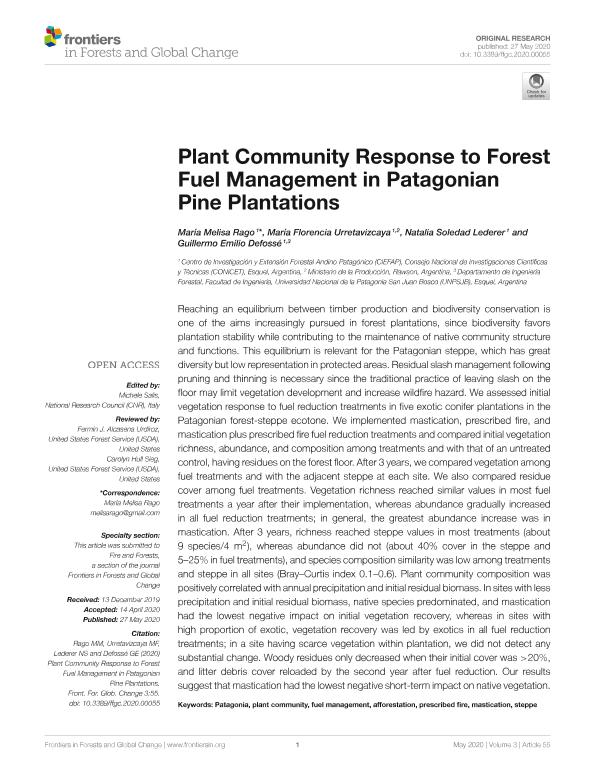Mostrar el registro sencillo del ítem
dc.contributor.author
Rago, María Melisa

dc.contributor.author
Urretavizcaya, María Florencia

dc.contributor.author
Lederer, Natalia Soledad

dc.contributor.author
Defossé, Guillermo Emilio

dc.date.available
2022-09-14T17:34:12Z
dc.date.issued
2020-05
dc.identifier.citation
Rago, María Melisa; Urretavizcaya, María Florencia; Lederer, Natalia Soledad; Defossé, Guillermo Emilio; Plant Community Response to Forest Fuel Management in Patagonian Pine Plantations; Frontiers Media; Frontiers in Forests and Global Change; 3; 5-2020; 1-20
dc.identifier.issn
2624-893X
dc.identifier.uri
http://hdl.handle.net/11336/168733
dc.description.abstract
Reaching an equilibrium between timber production and biodiversity conservation is one of the aims increasingly pursued in forest plantations, since biodiversity favors plantation stability while contributing to the maintenance of native community structure and functions. This equilibrium is relevant for the Patagonian steppe, which has great diversity but low representation in protected areas. Residual slash management following pruning and thinning is necessary since the traditional practice of leaving slash on the floor may limit vegetation development and increase wildfire hazard. We assessed initial vegetation response to fuel reduction treatments in five exotic conifer plantations in the Patagonian forest-steppe ecotone. We implemented mastication, prescribed fire, and mastication plus prescribed fire fuel reduction treatments and compared initial vegetation richness, abundance, and composition among treatments and with that of an untreated control, having residues on the forest floor. After 3 years, we compared vegetation among fuel treatments and with the adjacent steppe at each site. We also compared residue cover among fuel treatments. Vegetation richness reached similar values in most fuel treatments a year after their implementation, whereas abundance gradually increased in all fuel reduction treatments; in general, the greatest abundance increase was in mastication. After 3 years, richness reached steppe values in most treatments (about 9 species/4 m2), whereas abundance did not (about 40% cover in the steppe and 5–25% in fuel treatments), and species composition similarity was low among treatments and steppe in all sites (Bray–Curtis index 0.1–0.6). Plant community composition was positively correlated with annual precipitation and initial residual biomass. In sites with less precipitation and initial residual biomass, native species predominated, and mastication had the lowest negative impact on initial vegetation recovery, whereas in sites with high proportion of exotic, vegetation recovery was led by exotics in all fuel reduction treatments; in a site having scarce vegetation within plantation, we did not detect any substantial change. Woody residues only decreased when their initial cover was >20%, and litter debris cover reloaded by the second year after fuel reduction. Our results suggest that mastication had the lowest negative short-term impact on native vegetation.
dc.format
application/pdf
dc.language.iso
eng
dc.publisher
Frontiers Media

dc.rights
info:eu-repo/semantics/openAccess
dc.rights.uri
https://creativecommons.org/licenses/by/2.5/ar/
dc.subject
AFFORESTATION
dc.subject
FUEL MANAGEMENT
dc.subject
MASTICATION
dc.subject
PATAGONIA
dc.subject
PLANT COMMUNITY
dc.subject
PRESCRIBED FIRE
dc.subject
STEPPE
dc.subject.classification
Ecología

dc.subject.classification
Ciencias Biológicas

dc.subject.classification
CIENCIAS NATURALES Y EXACTAS

dc.title
Plant Community Response to Forest Fuel Management in Patagonian Pine Plantations
dc.type
info:eu-repo/semantics/article
dc.type
info:ar-repo/semantics/artículo
dc.type
info:eu-repo/semantics/publishedVersion
dc.date.updated
2022-09-14T14:17:33Z
dc.journal.volume
3
dc.journal.pagination
1-20
dc.journal.pais
Estados Unidos

dc.description.fil
Fil: Rago, María Melisa. Centro de Investigación y Extensión Forestal Andino Patagónico; Argentina. Consejo Nacional de Investigaciones Científicas y Técnicas; Argentina
dc.description.fil
Fil: Urretavizcaya, María Florencia. Consejo Nacional de Investigaciones Científicas y Técnicas; Argentina. Centro de Investigación y Extensión Forestal Andino Patagónico; Argentina
dc.description.fil
Fil: Lederer, Natalia Soledad. Centro de Investigación y Extensión Forestal Andino Patagónico; Argentina. Consejo Nacional de Investigaciones Científicas y Técnicas; Argentina
dc.description.fil
Fil: Defossé, Guillermo Emilio. Centro de Investigación y Extensión Forestal Andino Patagónico; Argentina. Universidad Nacional de la Patagonia "San Juan Bosco". Facultad de Ingeniería - Sede Esquel; Argentina. Consejo Nacional de Investigaciones Científicas y Técnicas; Argentina
dc.journal.title
Frontiers in Forests and Global Change
dc.relation.alternativeid
info:eu-repo/semantics/altIdentifier/url/https://www.frontiersin.org/article/10.3389/ffgc.2020.00055/full
dc.relation.alternativeid
info:eu-repo/semantics/altIdentifier/doi/http://dx.doi.org/10.3389/ffgc.2020.00055
Archivos asociados
